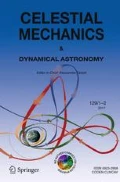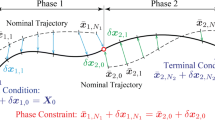Abstract
Recently, with new trajectory design techniques and use of low-thrust propulsion systems, missions have become more efficient and cheaper with respect to propellant. As a way to increase the mission’s value and scientific return, secondary targets close to the main trajectory are often added with a small change in the transfer trajectory. As a result of their large number, importance and facility to perform a flyby, asteroids are commonly used as such targets. This work uses the Primer Vector theory to define the direction and magnitude of the thrust for a minimum fuel consumption problem. The design of a low-thrust trajectory with a midcourse asteroid flyby is not only challenging for the low-thrust problem solution, but also with respect to the selection of a target and its flyby point. Currently more than 700,000 minor bodies have been identified, which generates a very large number of possible flyby points. This work uses a combination of reachability, reference orbit, and linear theory to select appropriate candidates, drastically reducing the simulation time, to be later included in the main trajectory and optimized. Two test cases are presented using the aforementioned selection process and optimization to add and design a secondary flyby to a mission with the primary objective of 3200 Phaethon flyby and 25143 Itokawa rendezvous.








Similar content being viewed by others
References
Bryson Jr., A.E., Ho, Y.-C.: Applied Optimal Control: Optimization, Estimation and Control. Revised Edition. CRC Press, New York (1975)
Campagnola, S., Russell, R.P.: Optimal control on gauss’ equations. 2nd IAA Conference on Dynamics and Control of Space Systems, March, Rome, Italy, IAA-AAS-DyCoSS2-14-14-01, IAA Academie Internationale d’Astronautique (2014)
Campagnola, S.: Linear reachability theory. ISAS/JAXA Internal Note, Institute of Space and Astronautical Science, Sagamihara, Japan, May (2015)
Campagnola, S.: Simple Fast Algorithm for Low-Thrust Guidance Problems. ISAS/JAXA Internal Note. Institute of Space and Astronautical Science, Sagamihara, Japan, December (2014)
Casalino, L., Colasurdo, G., Pastrone, D.: Optimal low-thrust escape trajectories using gravity assist. J. Guid. Control Dyn. 22(5), 637–642 (1999). doi:10.2514/2.4451
Colasurdo, G., Casalino, L.: Optimal control law for interplanetary trajectories with nonideal solar sail. J. Spacecr. Rockets 40(2), 260–265 (2003). doi:10.2514/2.3941
Gill, P.E., Murray, W., Saunders, M.A.: SNOPT: an SQP algorithm for large-scale constrained optimization. SIAM J. Optim. 12(4), 979–1006 (2002). doi:10.1137/S1052623499350013
HAYABUSA Project.: HAYABUSA Project—Science and Data Archive, Data Archives and Transmission System DARTS. Online Source: http://darts.isas.jaxa.jp/planet/project/hayabusa/ (2015). Accessed 30 Sept 2015
Jezewski, D.J., Faust, N.L.: Inequality constraints in primer-optimal, N-impulse solutions. AIAA J. 9(4), 760–763 (1971). doi:10.2514/3.6272
Jezewski, D.J., Rozendaal, H.L.: An efficient method for calculating optimal free-space N-impulsive trajectories. AIAA J. 6(11), 2160–2165 (1968). doi:10.2514/3.4949
Kawakatsu, Y., Itawa, T.: DESTINY mission overview: a small satellite mission for deep space exploration technology demonstration. The 13th International Space Conference of Pacific-Basin Societies, May, Kyoto, Japan, Vol. 146, American Astronautical Society (2012)
Kirk, D.E.: Optimal Control Theory: An Introduction. Dover, New York (2004)
Kluever, C.A., Pierson, B.L.: Optimal low-thrust three-dimensional Earth–Moon trajectories. J. Guid. Control Dyn. 18(4), 830–837 (1995). doi:10.2514/3.21466
Lantoine, G., Russell, R.P., Dargent, T.: Using multicomplex variables for automatic computation of high-order derivatives. ACM Trans. Math. Softw. 38(3), 21 (2012). doi:10.1145/2168773.2168774
Lawden, D.F.: Optimal Trajectories for Space Navigation, pp. 5–59. Butterworths, London (1963)
Lion, P.M., Handelsman, M.: Primer vector on fixed-time impulsive trajectories. AIAA J. 6(1), 127–132 (1968). doi:10.2514/3.4452
Martins, J.R., Sturdza, P., Alonso, J.J.: The complex-step derivative approximation. ACM Trans. Math. Softw. 29(3), 245–262 (2003)
McConaghy, T.T., Debban, T.J., Petropoulos, A.E., Longuski, J.M.: Design and optimization of low-thrust trajectories with gravity assists. J. Spacecr. Rockets 40(3), 380–387 (2003)
Pontryagin, L.S.: Mathematical Theory of Optimal Processes. CRC Press, London (1987)
Petropoulos, A.E., Russell, R.P.: Low-thrust transfers using primer vector theory and a second-order penalty method. AIAA/AAS Astrodynamics Specialist Conference and Exhibit, August, Honolulu, Hawaii, AIAA 2008-6955, American Institute of Aeronautics and Astronautics (2008)
Press, W.H., Teukolsky, S., Vetterling, W.T., Flannery, B.P.: Numerical Recipies in C. The Art of Scientific Computing. Cambridge University Press, Cambridge (1997)
Ranieri, C.L., Ocampo, C.A.: Optimization of round-trip, time-constrained, finite-burn trajectories via and indirect method. J. Guid. Control Dyn. 28(2), 306–314 (2005). doi:10.2514/1.5540
Ranieri, C.L., Ocampo, C.A.: Indirect optimization of spiral trajectories. J. Guid. Control Dyn. 29(6), 1360–1366 (2006). doi:10.2514/1.19539
Restrepo, R.L., Russell, R.: The shadow trajectory model for a fast low-thrust indirect optimization. 26th AAS/AIAA Space Flight Mechanics Meeting, February, Napa, California, AAS 16-523, American Astronautical Society (2016)
Russell, R.P.: Primer vector theory applied to global low-thrust trade studies. J. Guid. Control Dyn. 30(2), 460–472 (2007). doi:10.2514/1.22984
Sarli, B.V., Kawakatsu, Y., Arai, T.: Design of a multiple flyby mission to the Phaethon Geminid Complex. J. Spacecr. Rockets 52(3), 739–745 (2015a). doi:10.2514/1.A33130
Sarli, B.V., Kawakatsu, Y.: Orbit transfer optimization for asteroid missions using weighted cost function. J. Guid. Control Dyn. 38(7), 1241–1250 (2015b). doi:10.2514/1.G000359
Senent, J., Ocampo, C., Capella, A.: Low-thrust variable specific impulse transfers and guidance to unstable periodic orbits. J. Guid. Control Dyn. 28(2), 280–290 (2005). doi:10.2514/1.6398
Sims, J.A., Finlayson, P.A., Rinderle, E.A., Vavrina, M.A., Kowalkowski, T.D.: Implementation of a Low-Thrust Trajectory Optimization Algorithm for Preliminary Design, AIAA/AAS Astrodynamics Specialist Conference and Exhibit, August, Keystone, Colorado, AIAA 2006-6746, American Institute of Aeronautics and Astronautics (2006)
The Minor Planet Center: MPC, Minor Planet Center Orbit Database (MPCORB): The International Astronomical Union, October (2013). http://www.minorplanetcenter.org/iau/MPCORB/MPCORB.DAT (2013). Accessed 12 Oct 2013
Vadali, S.R., Nah, R., Braden, E., Johnson, I.L.: Using low-thrust exhaust-modulated propulsion fuel-optimal planar Earth–Mars trajectories. J. Guid. Control Dyn. 23(3), 476–482 (2000). doi:10.2514/2.4553
Yam, C.H., Kawakatsu, Y.: GALLOP: A low-thrust trajectory optimization tool for preliminary and high fidelity mission design. 30th International Symposium on Space Technology and Science, July, ISTS 2015-d-49. Kobe, Japan (2015)
Zhang, C., Topputo, F., Bernelli-Zazzera, F., Zhao, Y.-S.: Low-thrust minimum-fuel optimization in the circular restricted three-body problem. J. Guid. Control Dyn. 38(8), 1501–1510 (2015). doi:10.2514/1.G001080
Acknowledgments
The authors would like to thank Stefano Campagnola for his valuable inputs and comments during the course of this work and Jack Yeh for revising the text and providing comments on its improvement.
Author information
Authors and Affiliations
Corresponding author
Electronic supplementary material
Below is the link to the electronic supplementary material.
Rights and permissions
About this article
Cite this article
Victorino Sarli, B., Kawakatsu, Y. Selection and trajectory design to mission secondary targets. Celest Mech Dyn Astr 127, 233–258 (2017). https://doi.org/10.1007/s10569-016-9724-x
Received:
Revised:
Accepted:
Published:
Issue Date:
DOI: https://doi.org/10.1007/s10569-016-9724-x




